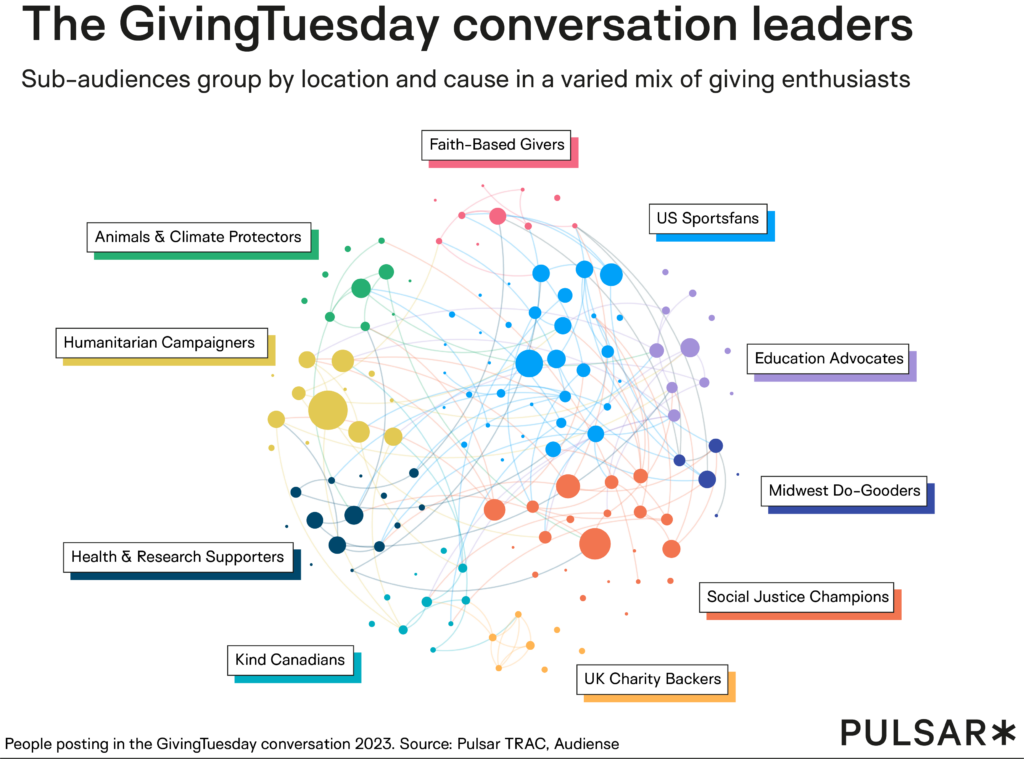Originally posted on the Pulsar blog.
As multiple globe- and population-spanning crises continue to develop, generosity is more vital than ever. People are finding ever-creative ways to ask for and give help, lend a hand, and express their generosity with audiences utilizing social spaces online to develop narratives that draw attention to meaningful ways to make change.
Once again, Pulsar and global generosity movement GivingTuesday have teamed up to analyze the ways people talk about giving. With official movements in nearly 100 countries, GivingTuesday unleashes the power of radical generosity around the world. Every year, on the Tuesday after American Thanksgiving, internet users make the hashtag #GivingTuesday go viral, inspiring people to become more generous in their daily lives and celebrating humanity’s common purpose.
Each year Pulsar collaborates with GivingTuesday to host a live dashboard which provides hourly updates on the keywords, hashtags, causes and types of appeal mentioned in conjunction with the #GivingTuesday hashtag. GivingTuesday’s Director of Digital Strategy Kathleen Murphy Toms also joined Pulsar CEO Fran D’Orazio in an episode of The Audiences Podcast, which get into details about the Audience of Generosity.
Here we look into the data behind GivingTuesday 2023 and dive into what ways audiences are using the world’s biggest giving day to instigate generosity.
While 2022’s top cause was Health & Healthcare, 2023 sees a return to Science & Education as the top cause – the same as 2021. Of course, Health & Healthcare continues to be extremely important to audiences, followed closely by Animal Welfare and Children & Elderly causes – these form the ‘big four’ of the GivingTuesday conversation.
Inside these cause-based conversations, we see posts for requests for help, donations and personal touches including stories and memories from those affected by the cause.
The past few years have seen Empowerment and Urgency rule the calls to action in the GivingTuesday conversation. However, 2023 sees appeals to Duty stepping forward as the most popular CTA.
When we look at the conversation in Duty, there’s a high prevalence of individuals and organizations writing long-form social posts to celebrate their achievements around GivingTuesday, highlighting reasons why what they’ve accomplished matters.
Here we see the direct increase in Duty-based messaging in 2023 in all areas of the Big Four except Animal Welfare. This Duty appeals to responsibility as a human to humanity around the world as world multicrises caused by humans are exacerbated by humans.
But who are the conversation leaders in the GivingTuesday conversation, exactly?
US Sportsfans are the most populous group and includes high-profile celebrities such as Matthew McConaughey and wrestler Cody Rhodes shouting out particular causes in conjunction with GivingTuesday. This group uses status and reach to give direct shout outs calling for generosity.
There are also specific segments of the audience that align purely geographically, with Kind Canadian, Midwest Do-Gooders and UK Charity Backers. It’s not uncommon to find audience segments aligning geographically, though here it’s important to note the jurisdictions shouting out the loudest for local change.
Social Justice Champions, the second-largest group, can be found requesting mutual aid to individual fundraising pages, as well as using GivingTuesday as an opportunity to gain virality with memes and calling out politicians for their behavior. They’re also foregrounding issues of global injustice, either stamping out hate in society or calling attention to those affected by international conflicts.
As we can see below, other than ‘giving’ and ‘Tuesday’, the most mentioned keyword in relation to #GivingTuesday is ‘support’, coming in above even ‘donation’ and ‘donate’. This is interesting to see, especially with the rise of Duty as a CTA. Both ‘support’ and Duty aim to appeal to a sense of necessity without instigating speed or urgency.
The eighth-most popular keyword is ‘thank’ – posters are placing emphasis on gratitude in relation to GivingTuesday. The 15th highest mentioned keyword isn’t directly related to charity or giving: ‘consider’. Here, individuals are asking others to consider an action, mindset change or piece of information. This reflects GivingTuesday’s mission: to not only raise money and awareness for charitable causes across the globe, but to change audiences’ attitude towards generosity and the way they give.
It’s no surprise that #donate comes in top as the most-used hashtag in relation to GivingTuesday – hashtags are often used as a quasi-call-to-action at the end of a post, with #donate acting as a short and sweet way of directly asking for monetary donations. The third- and fourth-most used hashtags, #giveback and #community, show a non-monetary focus however. Audiences are using hashtags to reinforce a wider form of generosity that appeals to human nature and coming together.
When it comes to supporting charitable causes, giving money isn’t the only option when being generous. Online conversation is showing that giving goods and time are becoming increasingly popular ways to get involved and give back, with volunteering garnering the most attention.
Donating money is an easy, liquid way of giving – it’s our most traditional and default form of helping a cause. But as the GivingTuesday generosity movement grows, and global multicrises become more complex, generosity is being taken offline worldwide. To hear more about giving behaviors are changing, tune into The Audiences Podcast episode The Audience of Generosity with GivingTuesday’s Kathleen Murphy Toms.
The thrill of getting is fleeting. The joy of giving lasts.
Data: happiness fades quickly when we buy gifts for ourselves, but sustains when we give gifts to others or donate to charity.
Giving is the greatest source of meaning.#GivingTuesday pic.twitter.com/nXjFTBBXjJ
— Adam Grant (@AdamMGrant) November 28, 2023






